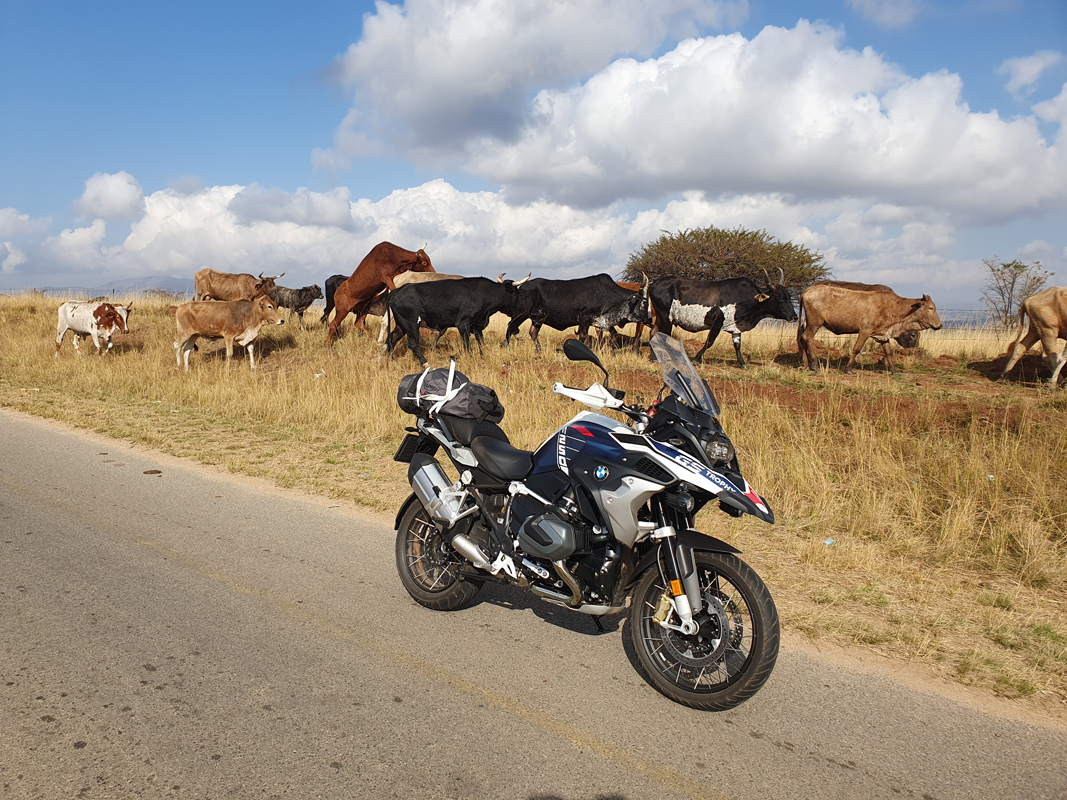
One of biking’s greatest pleasures is riding an unfamiliar road for the first time. There’s a unique thrill in setting off on a journey of exploration. The anticipation of what lies around the next corner or over the next hill fuels our wanderlust. Every ride is a blank canvas which we paint with the vivid colours of challenging roads, breathtaking panoramas, quaint places, unexpected adventures and friendly people.
I’ve ridden to Eswatini, Quondam Swaziland, dozens of times, almost always to jol at the outrageously excellent Swazi Rally. But I’ve never spent quality time discovering the country. I called my mate Carlos Paiva who hosts the Swazi Rally and asked him to be my guide for a few days. Carlos was keen and we arranged to meet in Piggs Peak at 11:00 on Tuesday morning.
My ride for the trip was a sparkling new BMW R1250GS Trophy with 1700km on the odometer. I left home in Nelspruit at 09:00 on a glorious sunny day meant for riding. I rode at speed to Barberton revelling in the Trophy’s agility over Hilltop Pass and through the flatstick sweepers in the valley of the Kaap River. From Barberton, it was 40km of exhilarating riding along the Eco Trail that leads into the mighty Makhonjwa Mountains. On this day thick mist hung wraithlike in the deep valleys lending an ethereal aspect to an already otherworldly vista.
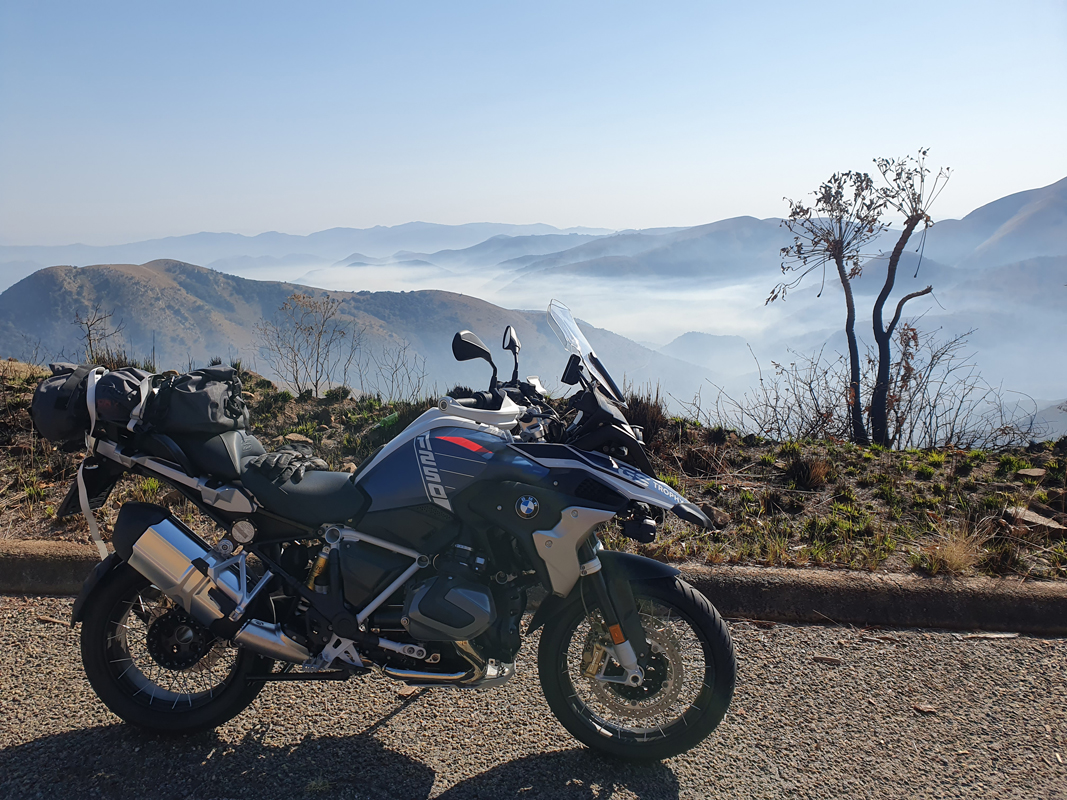
I was the only traveller at the Josefsdal and Bulembu border posts and within ten minutes I was loose on the land in the Kingdom of Eswatini, the only absolute monarchy on the African continent. The other absolute monarchies on the planet are The Emirates, The Kingdom of Saudi Arabia, The Sultanate of Brunei and The Vatican. This means that King Mswati III is a member of the world’s most exclusive club. The King holds unlimited power and all citizens owe their loyalty to the monarch.
Between 1939 and 2001 the Havelock Asbestos Mine operated in Bulembu. In the 1960s and 1970s, the mine was one the biggest producers of asbestos in the world and at its peak in 1976, the mine produced 42,000 tonnes of asbestos. But globally there was mounting evidence that asbestos was the cause of deadly lung diseases. Asbestos was declared the pariah of minerals and its use was outlawed by 66 countries including South Africa. When the mine closed in 2001 the employees abandoned the doomed town and overnight Bulembu became a ghost town. Five years later in 2006 the town and 1700 hectares of surrounding land were bought by Bulembu Ministries and the miners’ houses are now home to hundreds of AIDS orphans. On weekdays the children walk to school past the stark, grey 150-metre-high asbestos dumps that loom over Bulembu.
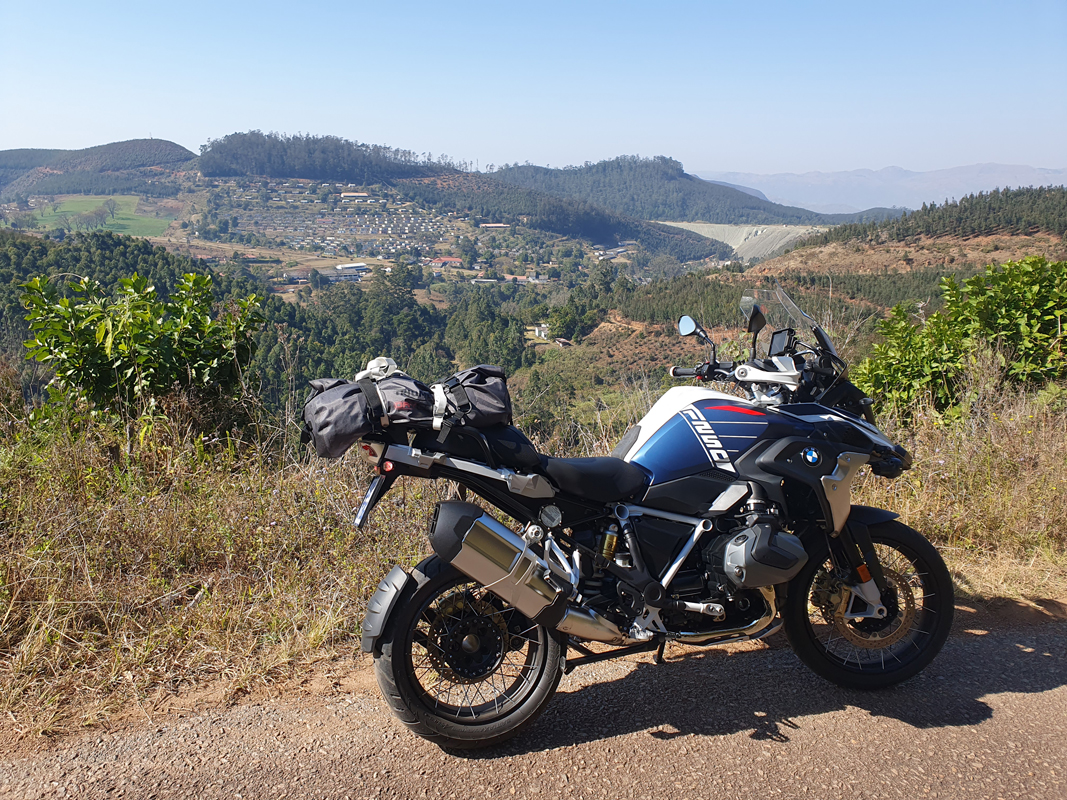
From Bulembu to Piggs Peak it’s 20km of dirt. The road is as rough as a bear’s arse but, paradoxically, not difficult to ride though there are some badly rutted uphill corners where you need to maintain revs and momentum. The big Beemer handled it with ease. It’s a scenic ride over mountainous terrain through plantations of eucalyptus and shortly before long I was tooling down the main drag of Piggs Peak for the rendezvous at KFC. These days my fodder of choice on the road is a KFC Bucket For One, an elegant sufficiency for about 40 Emalangeni. I had just finished eating when Carlos and Nhlanhla Maphanga pulled in, Carlos on his R1200RT and Nhlanhla on his R1200GS. While they scoffed their buckets we discussed the itinerary for the rest of the day.
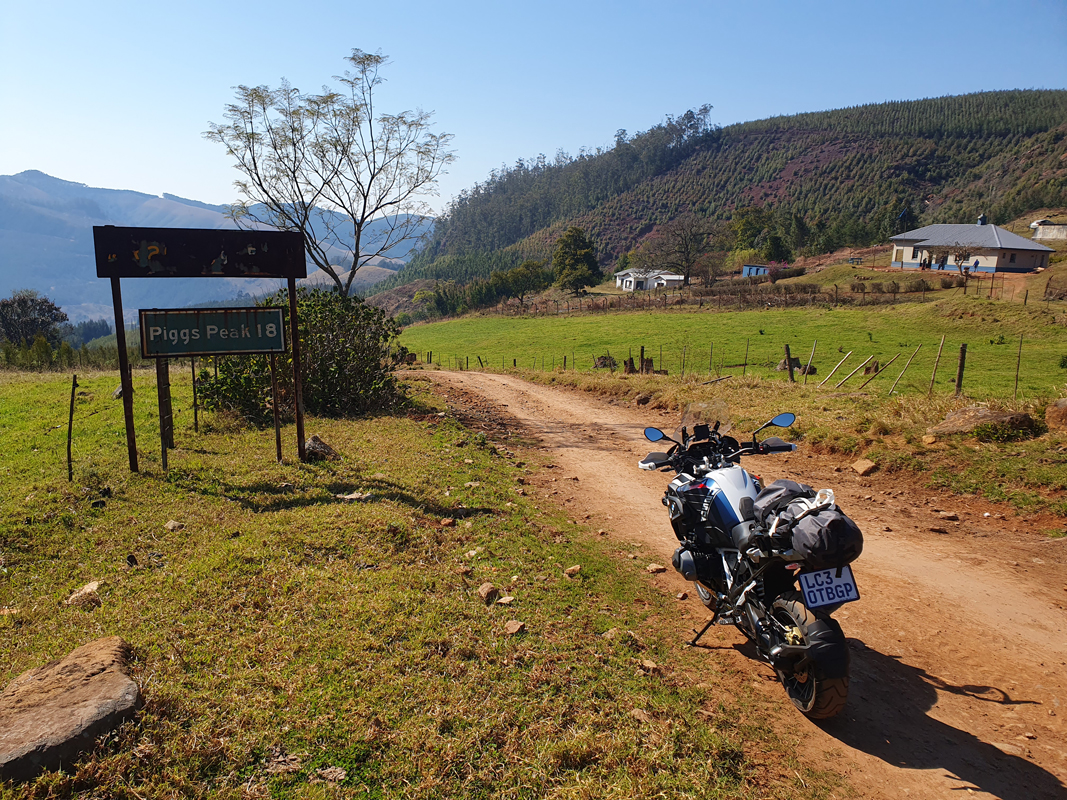
Nhlanhla was very knowledgeable about the area and suggested a first stop at Maguga Dam on the Nkomati River. We rode south on the MR1 with Nhlanhla setting a cracking pace. A few kilometres from Piggs Peak we hooked left onto a secondary road that brought us to the dam wall. It was a short walk to the viewing platform for photos of the massive 115-metre-high embankment which was completed in 2001. The dam was full to capacity thanks to bountiful summer rains; good news for the sugar cane plantations and small farms that rely on irrigation from Maguga. Nhlanhla explained that the road we were on was a loop around the dam so instead of riding back to the MR1 we continued south on a brilliant road that wound its way into the mountains past villages defended by speed humps. There are speed humps everywhere in Swaziland and you better have your eyes open because the humps are typically unpainted and steep-sided. Hit one at speed and you’ll regret it.
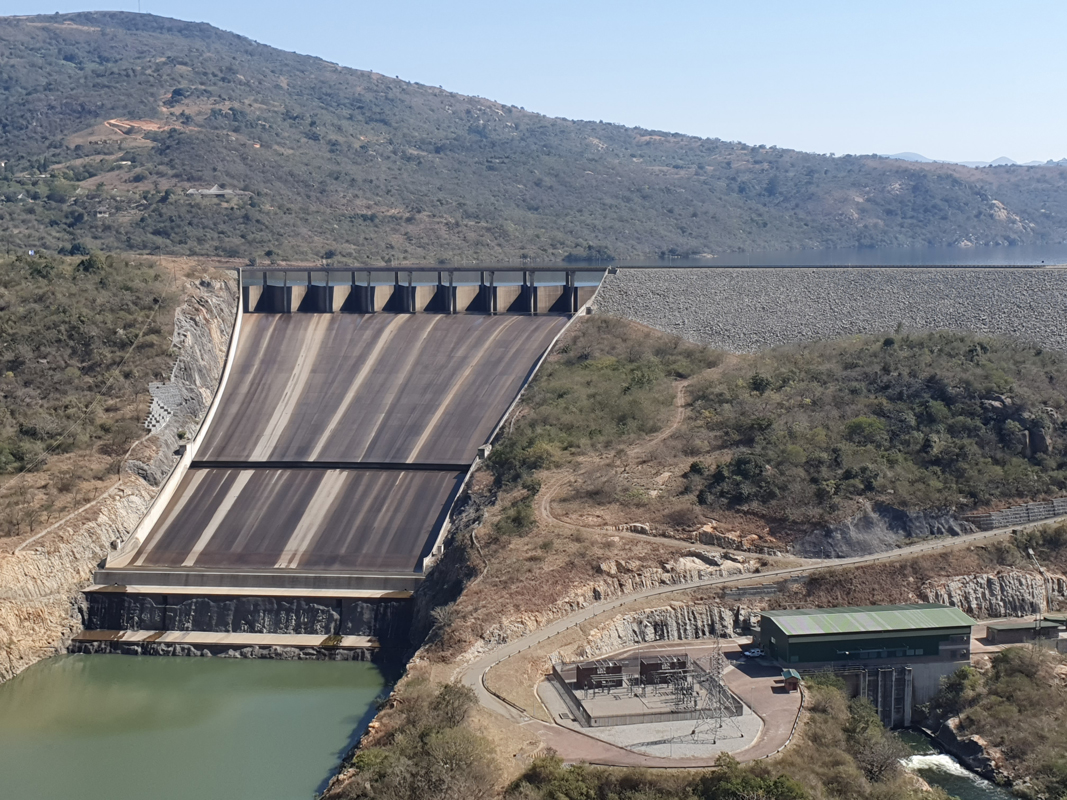
Back on the MR1 we crossed the bridge where the Nkomati enters the dam, returned to Piggs Peak and continued north for 10 kilometres until we came to the turnoff to Phophonyane Falls. We rode a few kilometres of easy dirt and cruised into the Phophonyane nature reserve which covers 600 hectares. At reception, we were informed that the “conservation fee” to enter was E70 each. It was good to be in the company of siSwati speakers who informed the receptionist that I was a very important and influential (Ahem) motorcycling journalist and that we would not be paying any irksome fees. We walked through a lush, cool subtropical forest to reach the river and then followed a hellish steep pathway down a mountainside to the base of the falls. As I stumbled down the path I said to Nhlanhla “These falls better be incredible because I’m probably gonna have a heart attack clambering back to the top.” The 80-metre high falls were spectacular and worth the effort. The climb back up was a baastid but I’m here to tell the tale so it couldn’t have been all that bad.
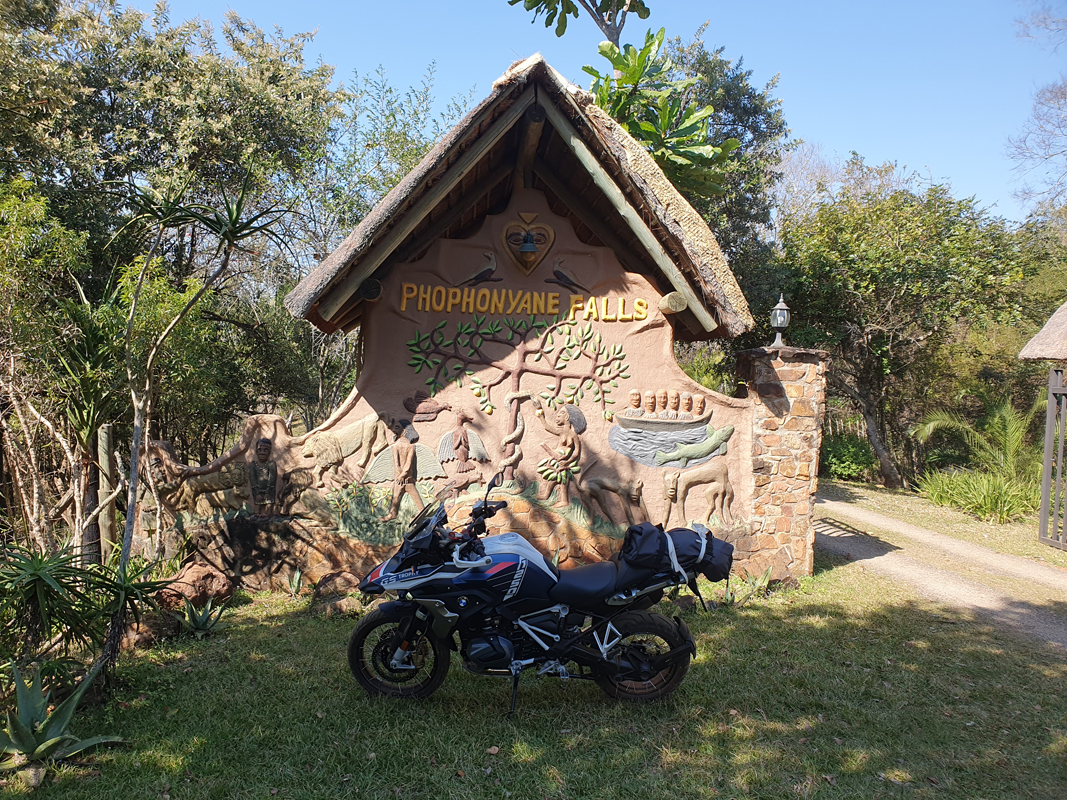
The Phophonyane Lodge is a swanky joint that caters to European tourists. Sitting on the shady veranda sipping our hard-earned Sibebe Lagers we were in the company of visitors from France, The Netherlands and Italy. I’m sure they were happy to pay the equivalent of €2 for a beer but I nearly had a second heart attack when I offered to pay and was presented with a bill for E135, a stinging E45 for a 330ml beer. I was very glad we hadn’t paid the euphemistically named “conservation fee”.
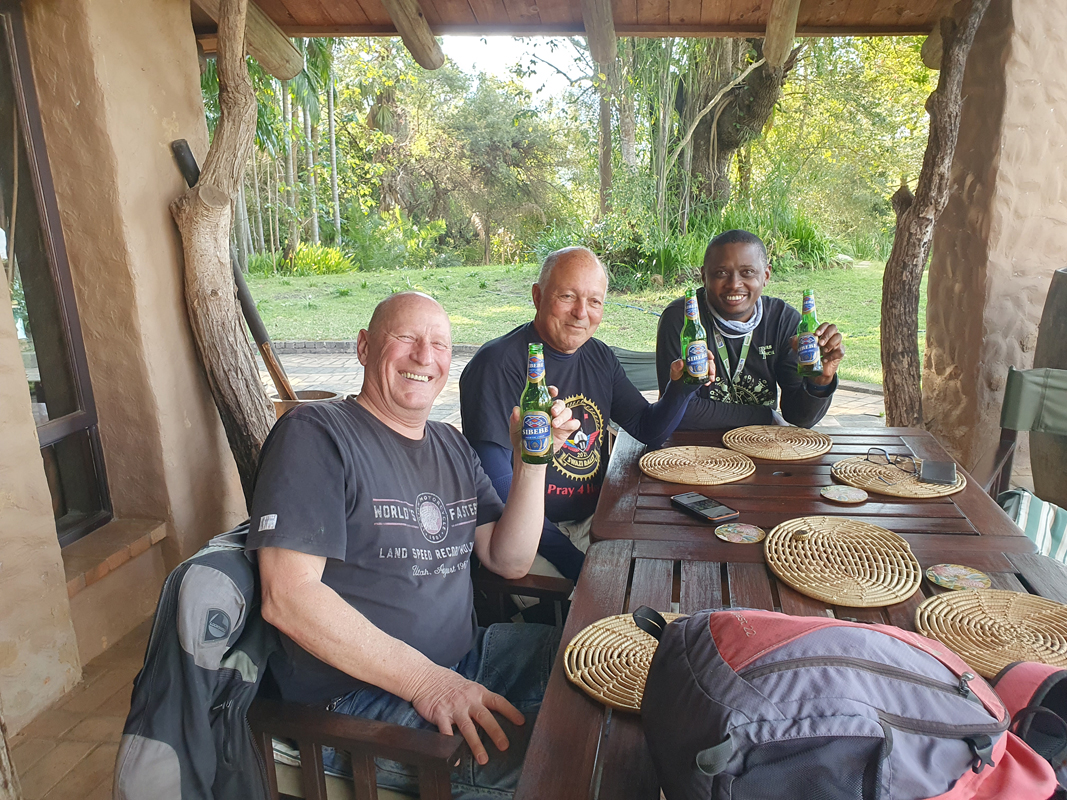
Nhlanhla suggested our last destination for the day should be Sibebe Rock on the outskirts of Mbabane. All good! Yet another place I had not visited before and even more new roads to ride. In warm late afternoon sunshine, we followed Nhlanhla, who clearly had a wild hair up his arse, and blitzed south on the MR1 across wild rocky hillsides. At the junction with the MR3 we turned southeast, howled down the freeway for a few clicks and then rode sedately into the busy suburbs of Mbabane. We turned north onto the Pine Valley Road and in less than 10 kilometres stopped for photos at the base of Sibebe Rock. After Uluru in Australia, this granite mountain is the second-largest monolith in the world and the largest exposed granite pluton, rising 350 metres above the valley of the Mbuluzi River.
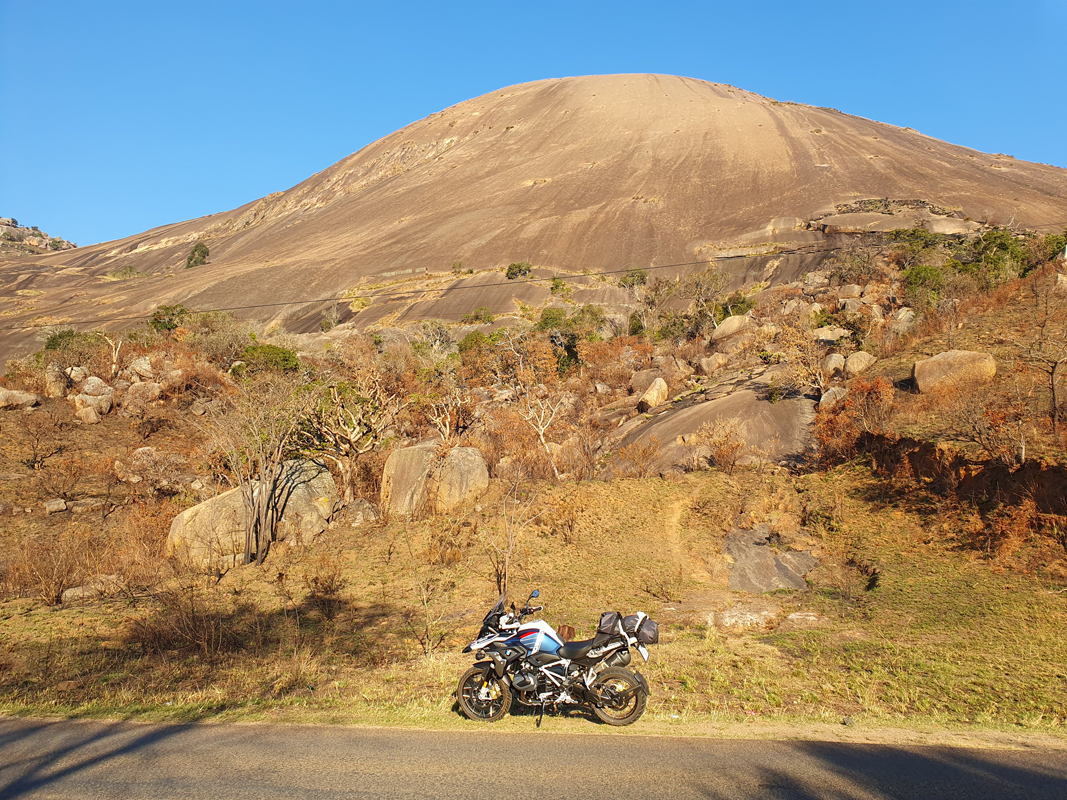
A few kilometres further on Nhlanhla led us onto a steep track that wound towards the summit of Sibebe. The surface of the track varied from dirt to tar to concrete to rocky middelmannetjies to horrible potholes but it was easy enough to ride and soon we arrived at the entrance to the Sibebe Resort. While Carlos and Nhlanhla were haggling about the entrance fee of E50 each I was observing an adult emu which seemed to be lurking with intent a couple of metres from the entrance. I made eye contact with the bird and it fixed me with a baleful glare and the next thing I knew I was in a staring competition with a bloody bird. We rode into the resort without paying and the emu charged at me flapping its wings, grunting and hissing and doing its best to kill me. I nearly soiled myself. Carlos and Nhlanhla were cackling like demented apes and I suppose, with hindsight, it was vaguely amusing. The views from the summit were stunning and the obvious thing to do was to drink a Sibebe on top of Sibebe and watch the setting sun. It was the perfect end to a great day in the saddle.
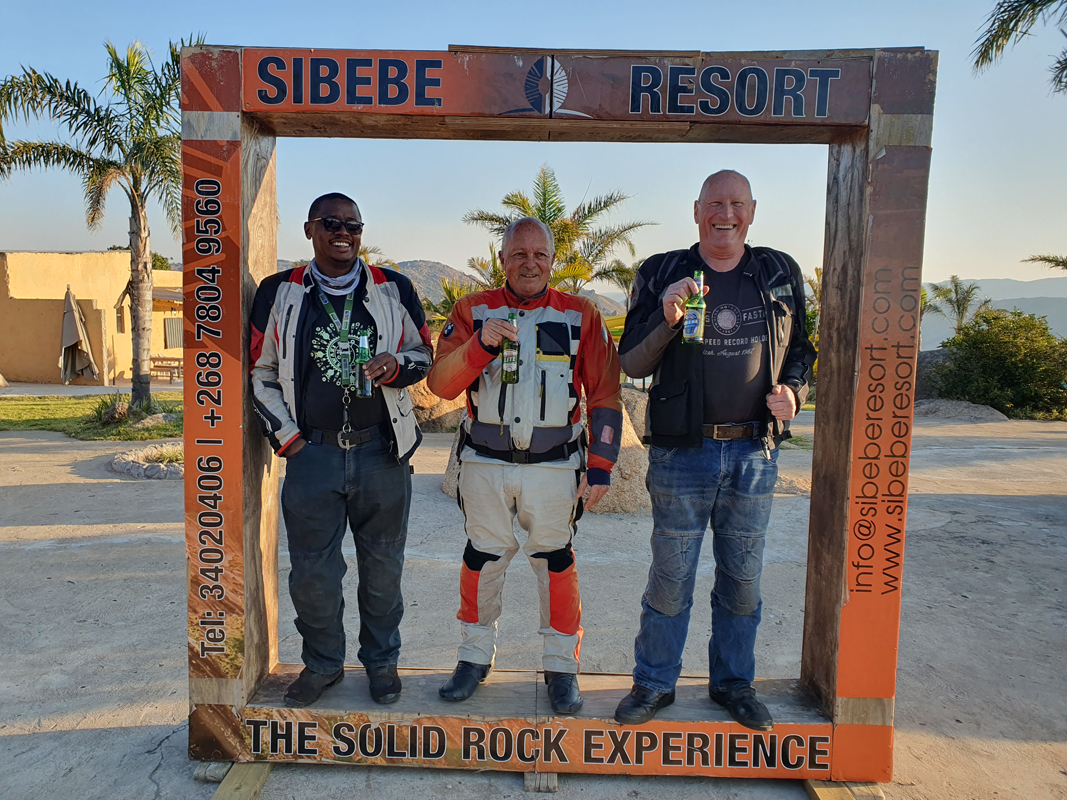
We rode back down the mountain and returned to Mbabane where Nhlanhla left us. Carlos and I rode through teeming rush-hour traffic and eventually rejoined the MR3. The freeway down the mountain from Mbabane is characterised by fast-flowing bends and a good grippy surface. We rode fast and soon we were on the plains heading for Manzini. Just before Manzini we turned south onto the MR9 and took it very easy as twilight fell. It was 15 kilometres to Sidvokodvo, 15 kilometres of cattle, pedestrians, speed humps and, taxis squeezing in the last trips of the day. Carlos owns Riders’ Ranch estate on the banks of the Great Usutu River and I was a guest in his home while I was in Eswatini. I spent a very happy evening in the company of Carlos and Sonia and the extended Paiva family. It was early to bed and I slept well dreaming of another day of adventures.
On Wednesday morning we rode south on the MR9. The plan for the day was to ride about 350km so time was on our side. The first stop was at Nkonyeni Golf Estate just a few kilometres from Riders’ Ranch. Carlos wanted to show me the quality of the accommodation available in Eswatini in case this article inspires you to visit the country. The rooms in the Bushbaby Lodge were brand new, bright, airy and reasonably priced at R1600 per couple, bed and breakfast. There’s plenty of good quality accommodation available countrywide and Google is your friend.
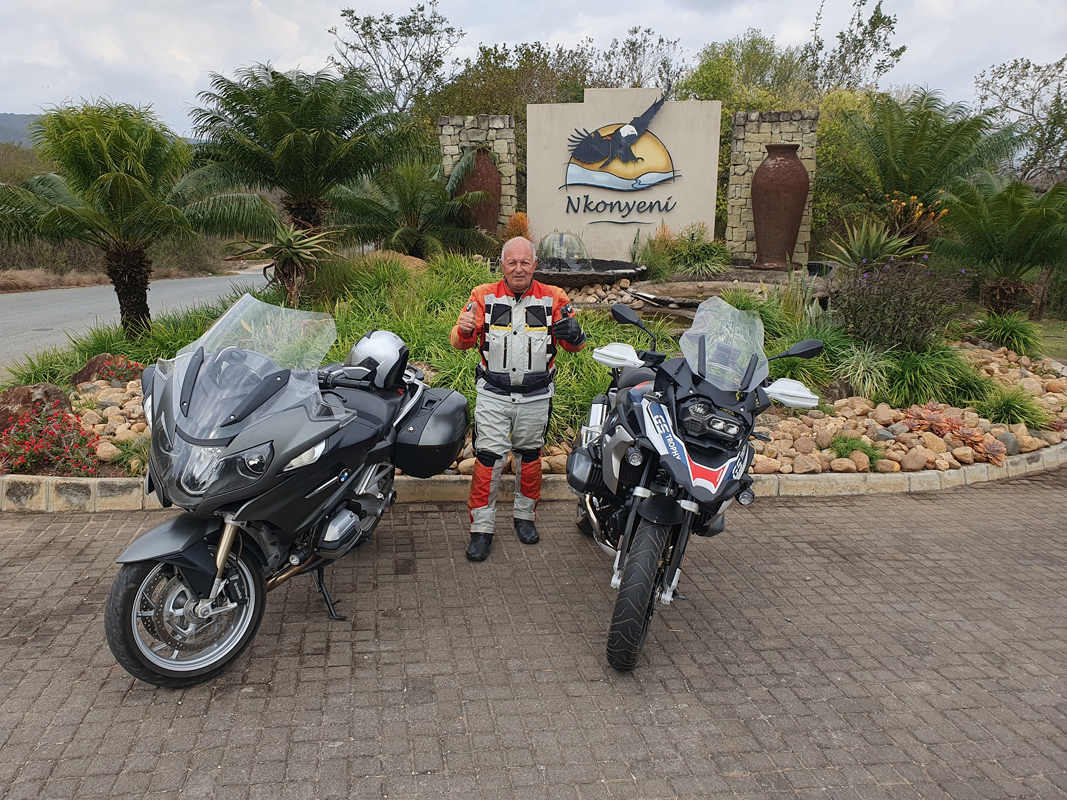
We continued south through the Grand Valley of the Mkhondvo River. I’ve ridden this road many times but always from south to north because it’s the route from Mahamba border post to Riders’ Ranch. The Grand Valley is a busy route so we rode at the speed limit enjoying the scenery, glimpses of the river and misty mountains on the western horizon. Brightly painted general dealers are a feature of the Eswatini roadsides and I stopped a few times for photos of the emporia. 40 kilometres south of Sidvokodvo there’s a low-level bridge over the river and I always stop there for photos. It’s an idyllic arcadian spot on the planet; the broad slow river flowing between grassy banks dotted with acacia trees and cattle grazing contentedly. We rode past Hlatikulu and ascended from the valley onto the southern highveld heading for Nhlangano.
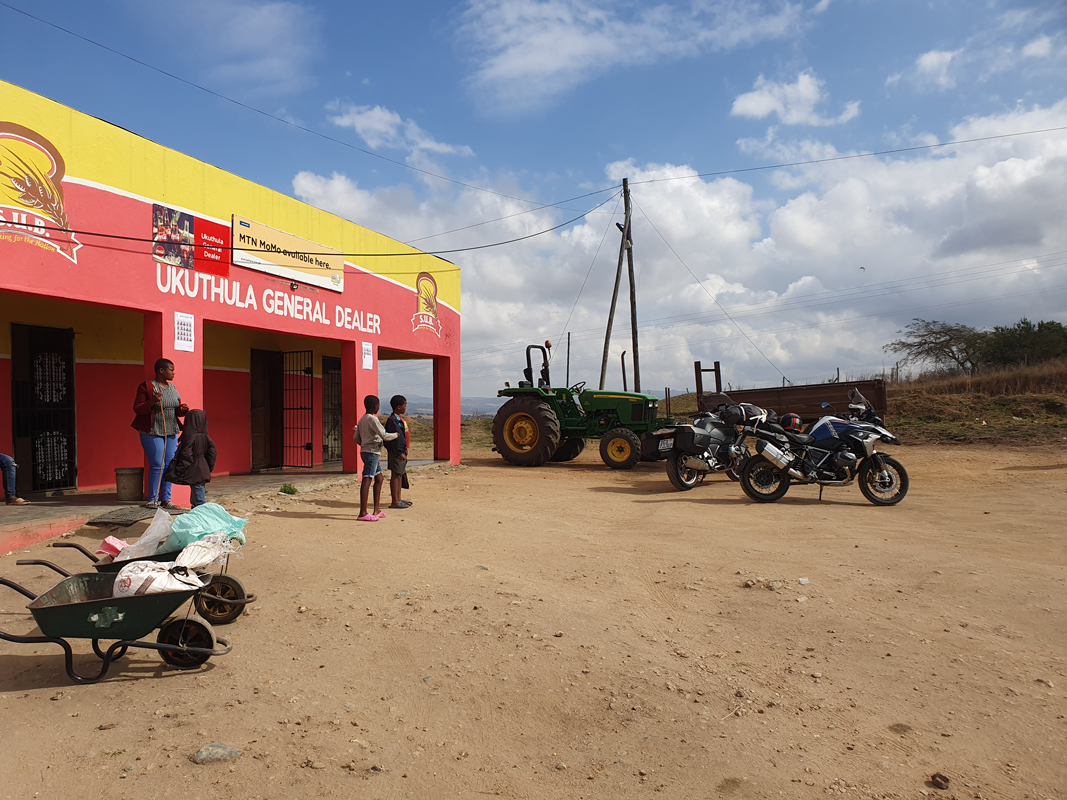
Nhlangano is a busy sprawling town which caters to the needs of the farmers and foresters in the surrounding area. We wanted to ride the MR11 east but the road was being rebuilt and we were obliged to ride through the chaotic CBD. On the far side of town, we eventually picked up the MR11, a road I had never ridden before. This magnificent winding road traverses hilly bushveld landscapes and undulating savannahs with distant views to the south of the Pongola River valley. The area is sparsely populated but still, there were cattle grazing the roadsides and vicious speed humps guarding the few habitations. Near Mhlosheni we stopped to speak to two woodcutters, their wagon drawn by six donkeys. Carlos engaged them in lively conversation. They were salt of the earth, hardscrabble men and yet there was a gentle aspect to their natures as they spoke affectionately about their donkeys each of which had a pet name.
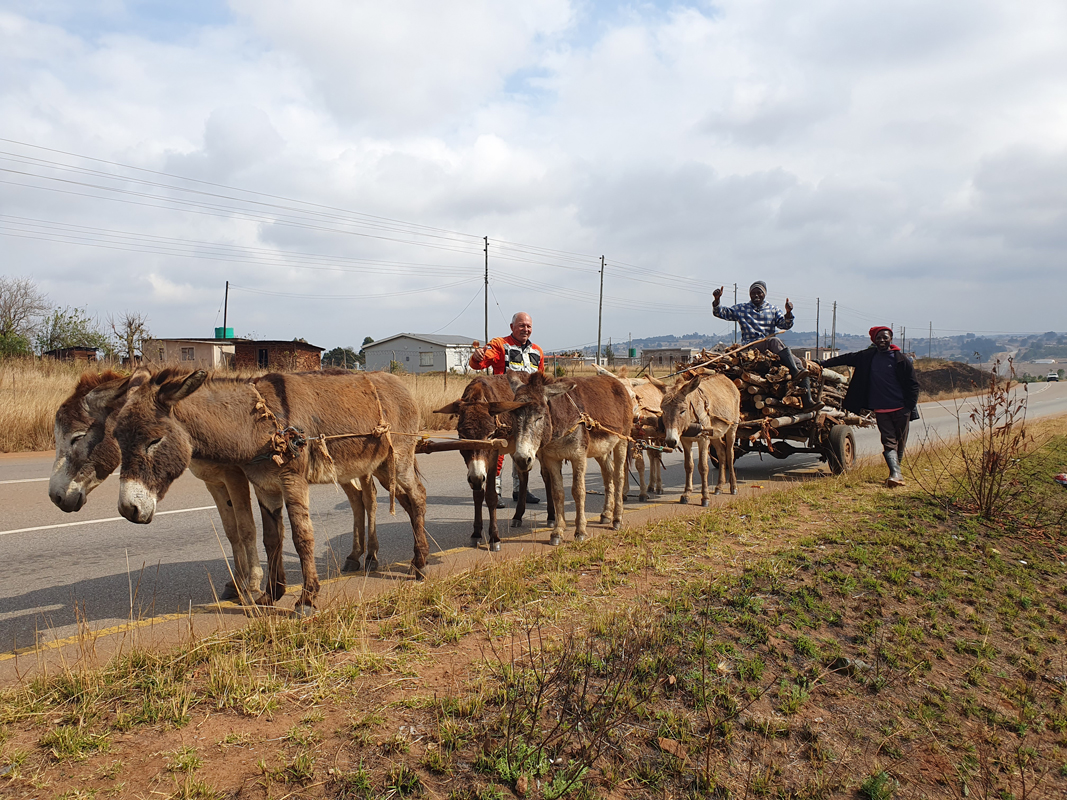
A few kilometres further we stopped for photos at the Bethel Evangelical Church. A local guy told us the church was built in the 1930s. Carlos must have remembered that I like taking photos of churches because apropos nothing he said to me “Would you like to visit the Catholic mission where I went to school in the 1960s? It’s called Our Lady of Sorrows. It’s a few clicks further along and not far off the road.” Of course, I said yes. Fifteen minutes later we rode into the grounds of the mission and parked the bikes beneath the benevolent gaze of a marble statue of the Virgin Mary.
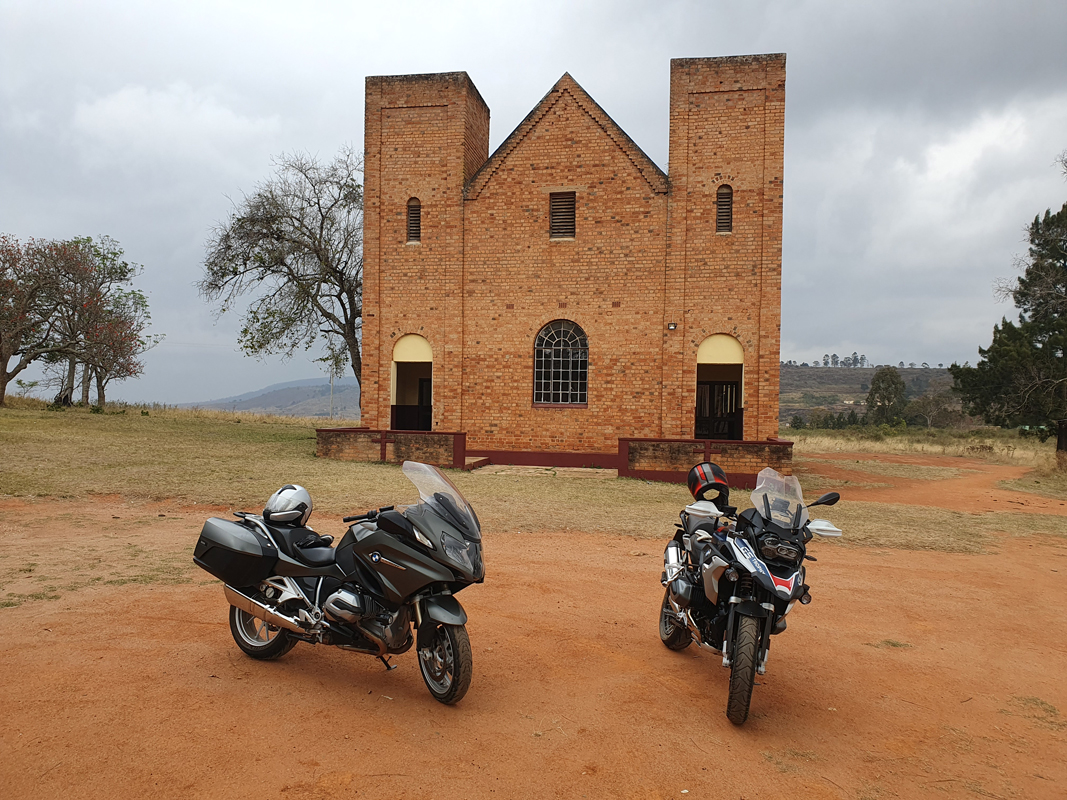
Carlos has maintained contact with the mission over the years and went into the office to see who was there. He came back accompanied by Sister Terezita who, as a young woman, left her home in Italy and has been at the mission for 44 years. We walked to the cemetery and I was surprised to see fresh flowers on many graves. There was a row of eleven identical graves, each one the final resting place of an Italian sister who had dedicated her life to the children of Eswatini. The first of these lovingly tended graves contains the mortal remains of Mother Claudia Gonfiantini who was laid to rest aged 98. The visit to the mission was a fascinating detour, an unexpected glimpse into an aspect of the country I had never encountered before.
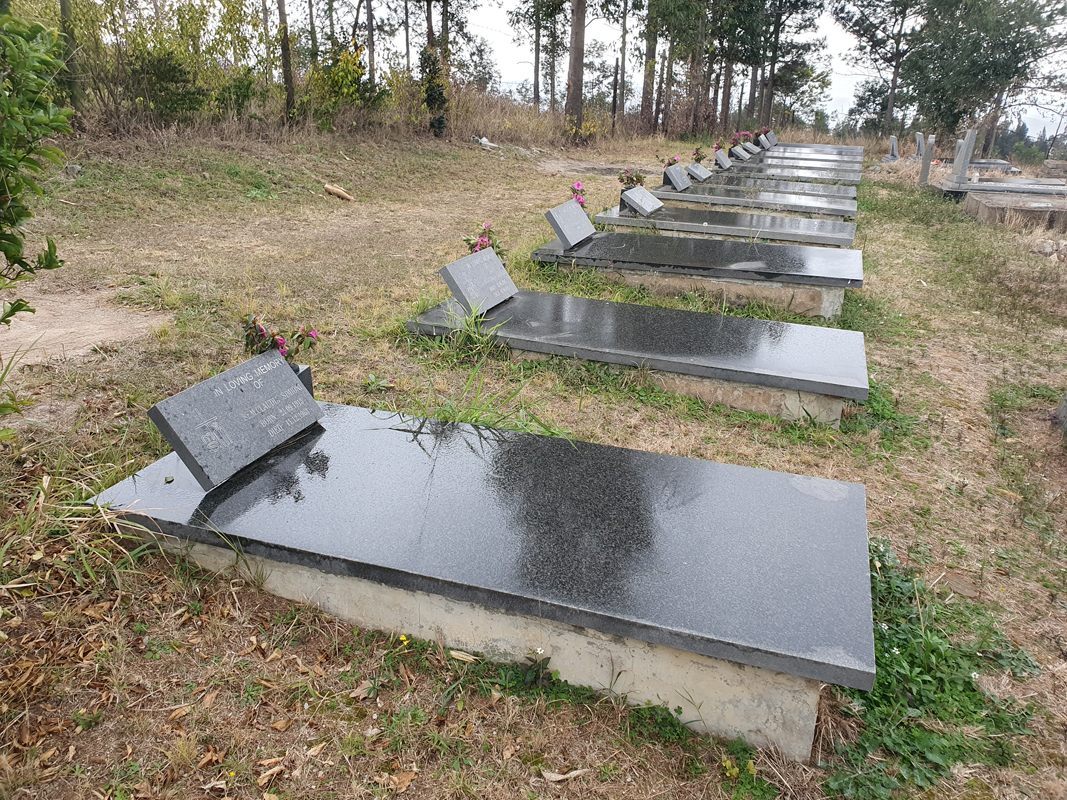
We continued eastwards at a relaxed pace. As we approached Lavumisa I spotted a yellow and pink general dealer with a bottle store next door. It was 13:30 and warm. The name of the shop was Walala Wasala which, in siSwati, means “You snooze, you lose” which just so happens to be the slogan on Swazi Rally T-shirts. It was written in the stars that we should stop there for a Sibebe Lager. Carlos and I were standing in the sunshine sipping our beers when I realised we were the foci of attention for the half dozen locals lolling on the veranda. It seemed rather boorish to be drinking in the presence of thirsty people so I bought six beers and dished them out. Instantly the vibe at Walala Wasala changed from ennui to animation and we spent the next half hour hanging with our new best friends taking photos and saying “Cheers!”
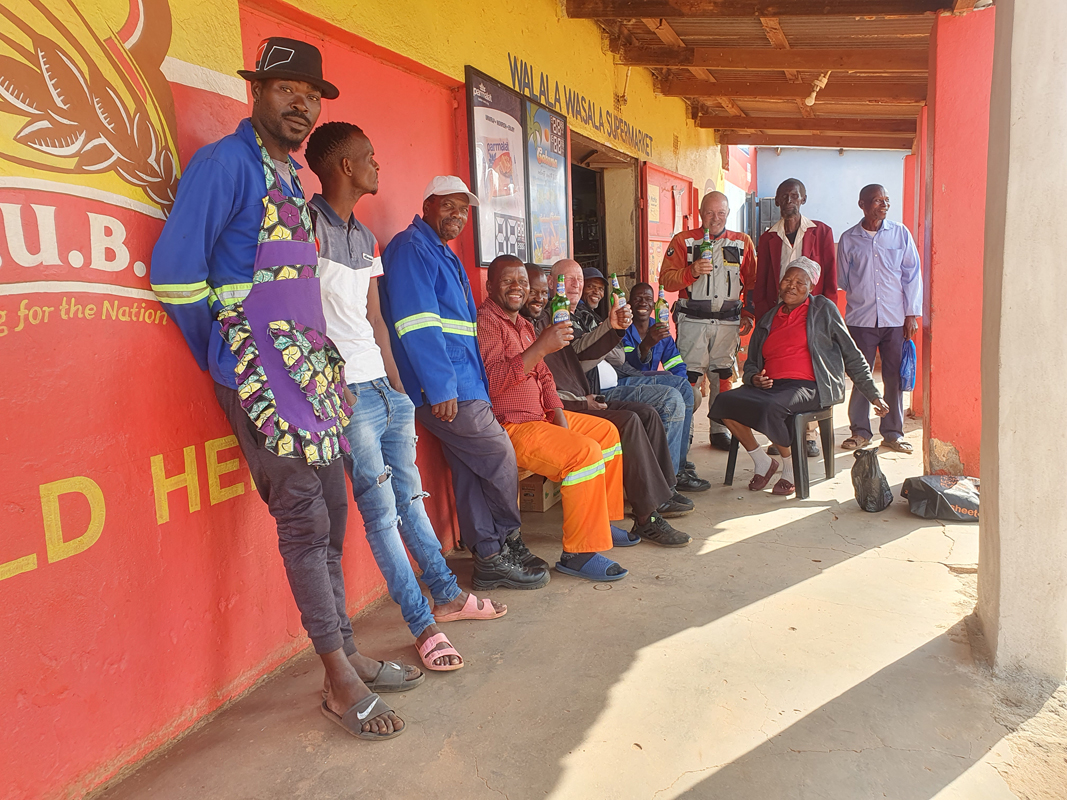
In Lavumisa we turned north on the MR8. To the east, there were views of Jozini Dam and for the rest of the ride north, the bulwarks of the Lebombo Mountains dominated the eastern horizon. We were in bushveld country with game fences on both sides of the road. For once we didn’t have to worry about cattle. As we approached Kamsholo Safaris Carlos indicated right. “What’s the fastest lunch?” “Chicken wrap.” Service was swift, the wrap was good and half an hour later we were back on the road. Big Bend, so named because the town is situated on a 180-degree bend in the Great Usutu River, is the hub of the vast sugar cane fields that stretch for tens of kilometres in every direction. We stopped at the Ubombo sugar mill for photos of the constant stream of cane transporters that feed the mill’s hungry maw. The mill produces 300,000 tonnes of sugar per annum and produces all its own electricity requirements from renewable sources.
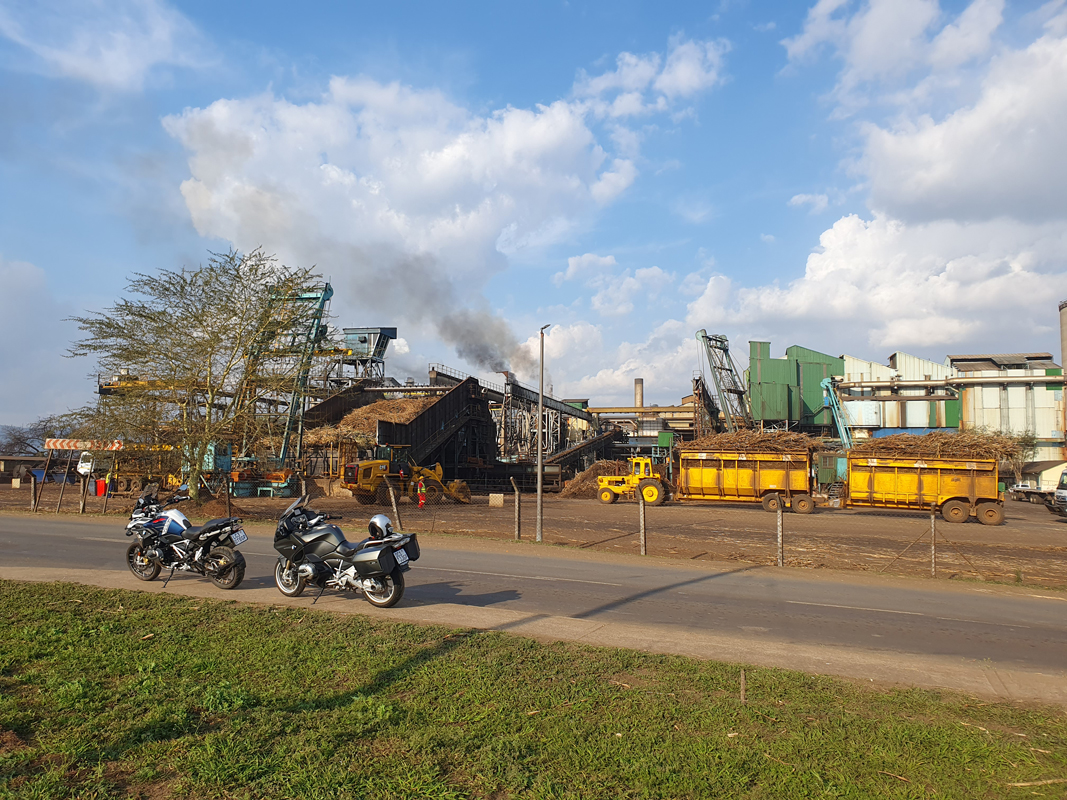
From Big Bend, we followed the MR16 due north to Siteki and then hooked east to King Mswati III International Airport. When the airport opened in 2014 it was viewed as a white elephant but traffic has increased and these days Airlink and Eswatini Air connect the kingdom to Southern African destinations. There wasn’t much to see at the airport so I took a photo of the statue of the lion at the entrance before we headed for home. What’s truly remarkable about the airport is the 40-kilometre four-lane freeway from the airport to Manzini. It’s a beautiful road and almost deserted; there’s not a lot of traffic to the airport. We raced to Manzini at 180 and by 17:30 we were back at Riders’ Ranch. Over dinner that evening I asked “I’ve been here for two days and there hasn’t been any load shedding. How come?” “Oh we don’t get load shedding in Eswatini.“ “But doesn’t your electricity come from South Africa?” “80% of our electricity comes from South Africa.” And yet there’s no load shedding in Eswatini! Go figure!
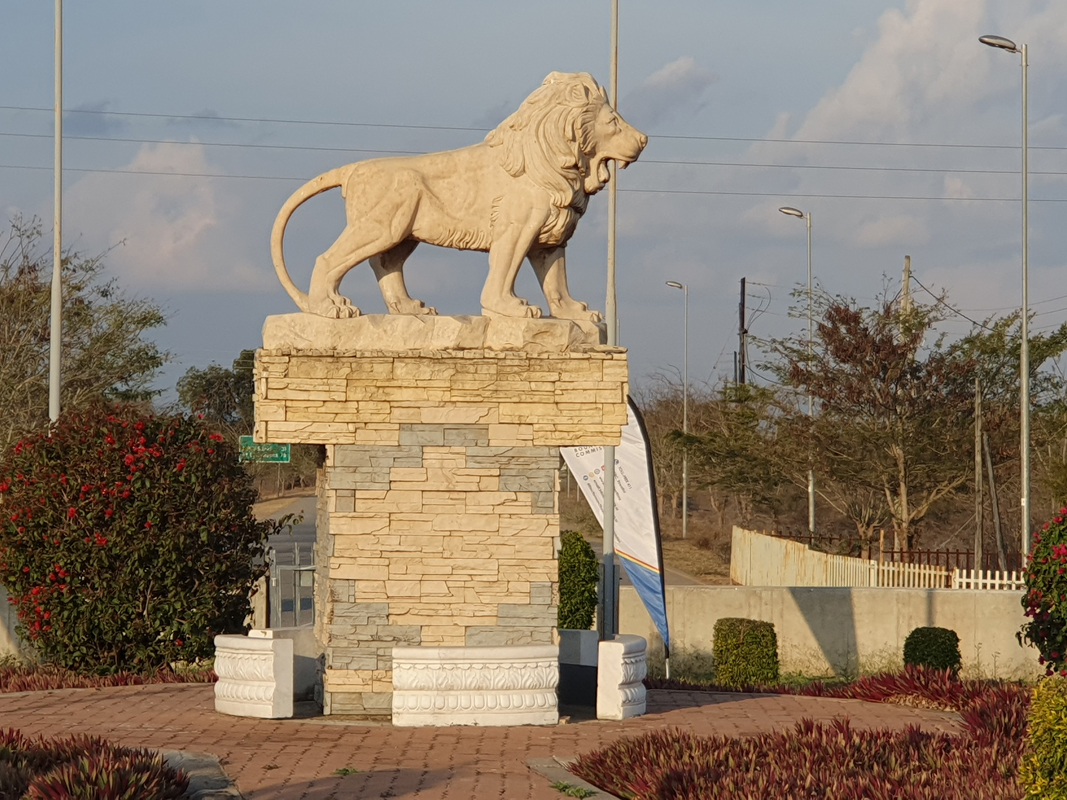
My Thursday itinerary included a visit to the Samora Machel Monument which is in South Africa, very close to the point where the borders of Mozambique, Eswatini and South Africa meet. I thought I would be riding alone but Carlos said a visit to the monument was on his bucket list and he would join me. East of Manzini we left the airport freeway and headed north to Luve and Bhalekane. Time was on our side and we rode at a leisurely pace enjoying the contrast between bush-covered mountains and emerald fields of sugar cane in the valleys. We turned right at the T junction in Bhalekane, and rode across the sugar cane plains surrounding the Sand River Dam. The Mananga border post was as quick and easy as expected and within ten minutes we were riding the R571 to Komatipoort. 20 kilometres from the border we found the sign pointing to the Samora Machel Memorial. The distance from the turn-off to the monument is 30 kilometres. It’s an amazing ride from the lowlands up into the Lebombo Mountains with remarkable views to the west. The road to the memorial is well-signposted.
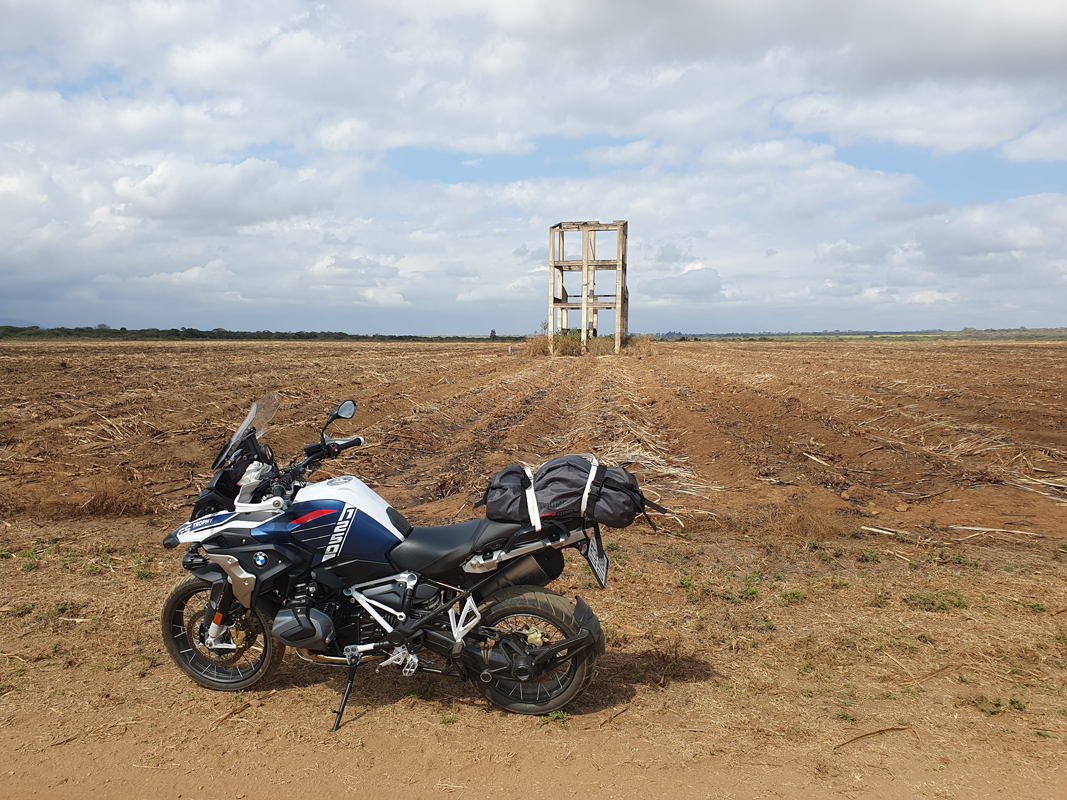
In the early afternoon, we stopped the bikes on a lonely mountainside near the village of Mbuzini where a tragic accident occurred on 19 October 1986. Samora Machel, President of Mozambique, and his entourage were returning to Maputo from Zambia aboard a Tupolev Tu-134. There were 35 passengers aboard the aircraft and nine crew of whom five were the highly experienced Russian cockpit crew. To this day the cause of the crash is a contentious subject but what is not disputed is that there was nothing mechanically wrong with the aircraft. It was a dark night and the crew were, in fact, lost. At 21:21 the pilot flew the plane into the ground, an aeronautical incident known as CFIT – Controlled Flight Into Terrain. Of the 44 souls on board 35 were killed. President Machel was one of the fatalities.
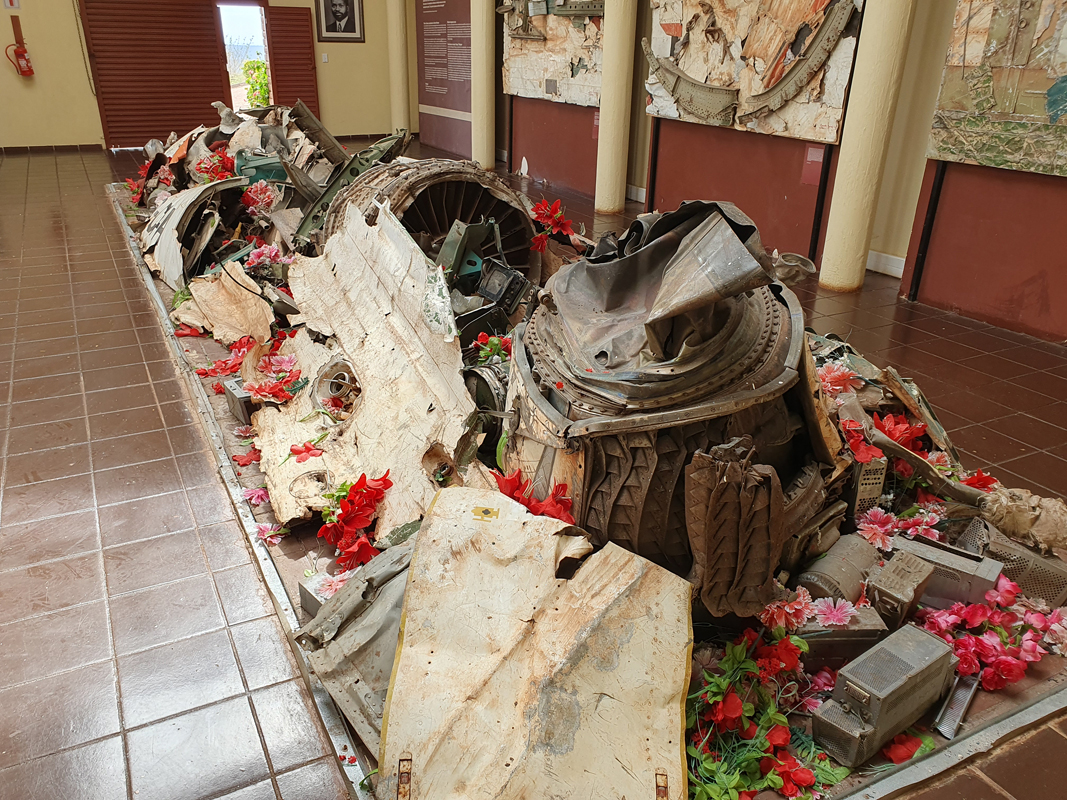
The monument at the crash site is a spiritual place and well worth a visit. The exhibits include the engines and pieces of fuselage from the doomed Tupolev. The photographic exhibits tell the story of the crash and accompanying texts give details of the conspiracy theories about the crash. Perhaps the most poignant feature of the monument is the concrete plinth where 35 wind flutes reach to the sky. Each tube represents one of the lives lost in the crash. Vertical slots in the tubes are designed to emit sounds of various tones when the wind blows across the tubes. On this day there was a strong wind blowing up from the valley and the wind flutes sang a mournful dirge, an eerie lament for the Mbuzini dead.
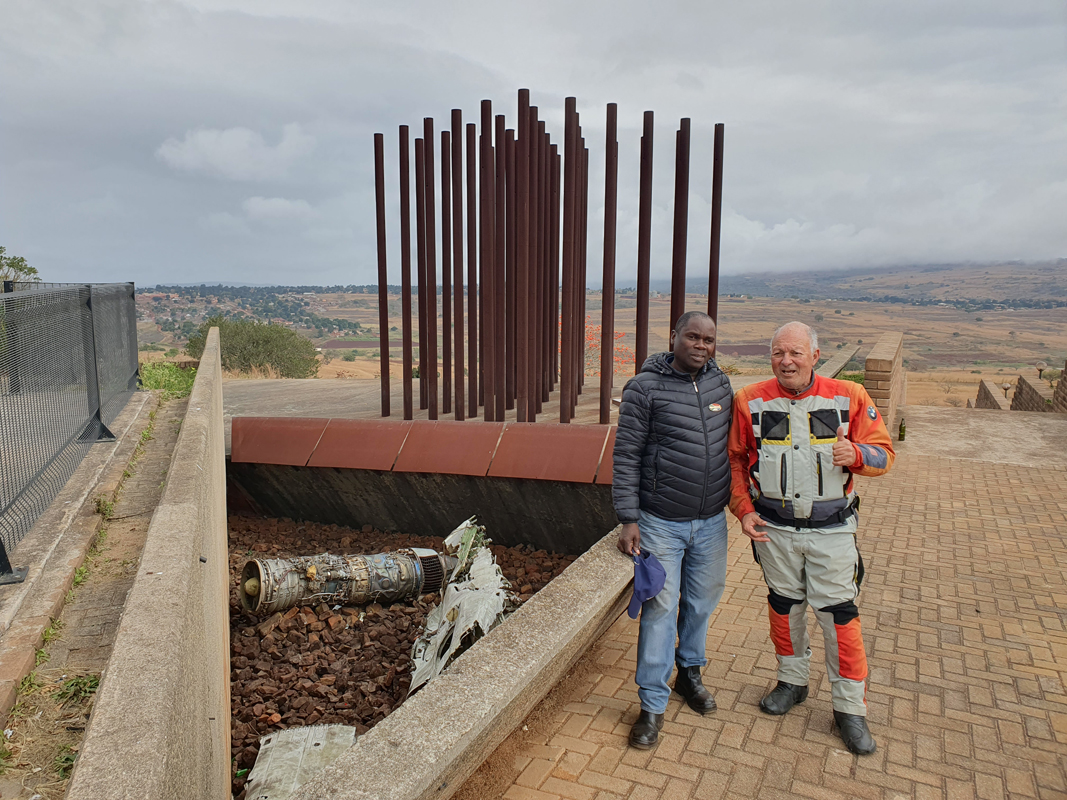
We rode away from the monument and stopped at the MSU Sports Bar for one last golden throat charmer to celebrate an excellent three-day adventure. Back on the flatlands at the foot of the Lebombos, we said our farewells. Carlos rode south to Eswatini and I rode north to Komatipoort where I turned west on the N4 and rode 100 kilometres home to Nelspruit.
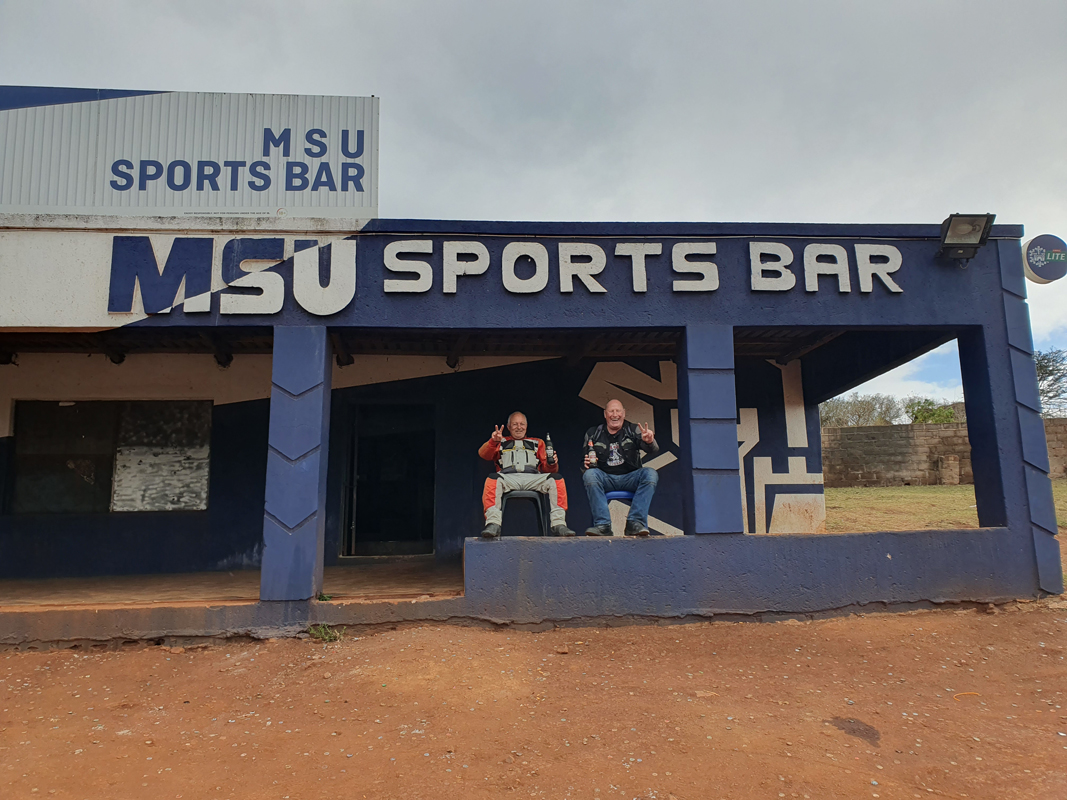
Go and ride Eswatini while you’re still young. It’s a wonderful friendly destination and you’re guaranteed to ride roads you’ve never ridden before. Adventure awaits!




